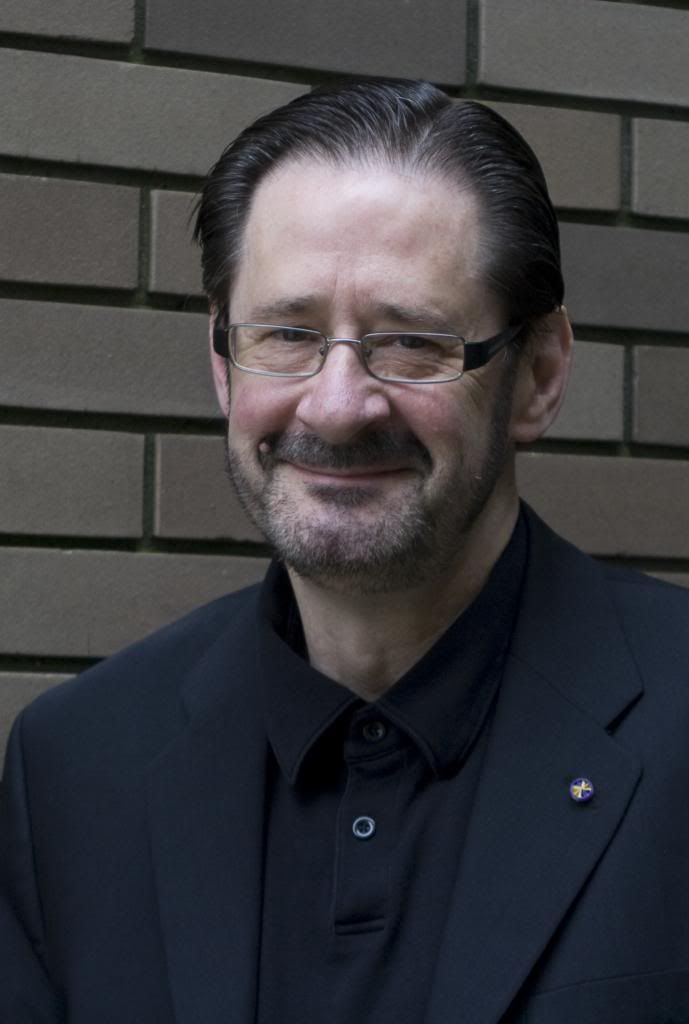The opening of Martin Bresnick's BE JUST! reveals the composer's adept skill at crafting evocative musical material, and then immediately subverting it.
It begins with a crash, but this crash is not nearly as ominous or seductive as the motoric texture that emerges in its wake. Only in Bresnick's music can such a crash be undermined by a simple string of repeated piano and vibraphone notes, intermittent violin harmonics, and dizzying clarinet fragments. Over the course of the four-minute piece, this steadily driving texture is stabbed, interjected, and flipped on its head. When it is finally interrupted by the crash with which the piece began, it quickly coalesces and re-emerges, building to fearsome and defiant climax. Named for the would-be inscription from Kafka's "In the Penal Colony", the piece weaves a narrative of increasing struggle, and of a momentum which is continuously disrupted.
Over the coming weeks, Edge of the Center will be profiling the many internationally-renowned artists who will be participating in this year's
June in Buffalo festival. This week, we look at faculty composer
Martin Bresnick.
Bresnick's work is often hard to pin down. While there are undeniable aspects of (post-) minimalism, these are often capsized by a densely chromatic harmonic lexicon. Yet this very chromaticism often dissolves into more open, Copland-esque sonorities. As
Kyle Gann notes, Bresnick's music has a thorny elegance, "His gestures can be murky at the same time that his pitch logic, often couched Brahmslike in hovering thirds and sixths, can be luminously transparent." While his work often features lively—even joyful—rhythmic exuberance, there remain dark undertones, as if his work is haunted by a kind of 21st century American expressionism.
Bresnick perhaps acquired this stylistic eclecticism from György Ligeti, with whom he studied in the early 1970s. The similarities are fitting: while Ligeti was inspired from sources as diverse as West African drumming, American minimalism, Hungarian folk music, and the European avant garde, his music never smacked of musical tourism or cultural appropriation. Likewise, Bresnick's music always only sounds like Bresnick. Whether he is writing works inspired by Kafka texts, or Indigenous American folk songs, he maintains a flexible compositional language that is at once consistent and diverse. "I had to develop a method of composition that would be sufficiently free but also sufficiently integrally-made so that it could support anywhere I wanted to go."
While never overt or polemical, Bresnick's work often hints at a progressive political perspective, which has been at work in the composer's output since the beginning. "It's true that my music is often concerned with the insulted, the oppressed, the downtrodden—the Sancho Panzas rather than the Don Quixotes, the horse of Alexander the Great rather than Alexander himself." Bresnick here refers to Bucephalus, his second string quartet, written in 1984, named for the general's famous steed. The work alternates between extremes of ferocious double-stop attacks, spikily disjunct, sinewy gestures, and briefer glimpses at a transcendent ethereality. As composer and Bresnick student Christopher Theofanidis observes, this is characteristic of Bresnick's work: "Behind the music is this Beethovenian rigor. You struggle to get where you’re going, and although unexpected moments of grace come up, it’s the struggle itself that is fundamental."
Bresnick is widely respected as a composition teacher, and is perhaps as renowned for his teaching as he is for his music. Among his students are composers as varied as film composer Marco Beltrami, recent Pulitzer Prize winner Kevin Puts, orchestral composers Theofanidis and Daniel Kellogg, jazz pianist Jack Perla, and, perhaps most famously, members of the Bang on a Can collective (David Lang, Michael Gordon, Julia Wolfe, Evan Ziporyn). As reviewer Joshua Kosman puts it, "If there is no very obvious Bresnick style, there is no Bresnick school either."
As a teacher, Bresnick is at once pragmatic and intellectual—his expansive knowledge of music history, literature, and philosophy allow him to consider the more abstract, scholarly aspects of art, while maintaining an ebullient, down-to-earth practicality, never losing sight of the essential components of compositional craft. David Lang has compared studying with Bresnick to a kind of musical therapy: "He’ll listen to you and then ask you the question that makes you think one inch farther than you’ve thought so far. He’s not telling you what to write, but asking you to think more carefully about what you were doing already."
Some writers have been quick to draw comparisons between Bresnick and Nadia Boulanger, the French pedagogue who rigorously trained an earlier (and equally varied) generation of American composers (including Aaron Copland, Elliott Carter, Philip Glass, and Quincy Jones). Refusing such analogies, Bresnick instead sees himself as more of a Camille Pissarro, the early Impressionist painter (and Jewish anarchist—a detail not overlooked by Bresnick) who engaged in mutual influence with younger artists like Gauguin, Degas, Monet, and Van Gogh. "Even after all these years I don’t see myself as somebody on a mountaintop with a bunch of tablets," Bresnick remarks in a profile by Steve Smith. "I see myself as one of the chosen, wandering in the desert. I’ve just been out there longer. When people come to me for teaching, I think they see that this is a person who has blood on his clothes and has been torn up a bit in his struggle, just as they struggle to achieve something."
We're excited that Bresnick will be joining us at June in Buffalo this year, encouraging the next generation of composers to think one inch farther, and continuing to engage with them in the struggle.
—Ethan Hayden






